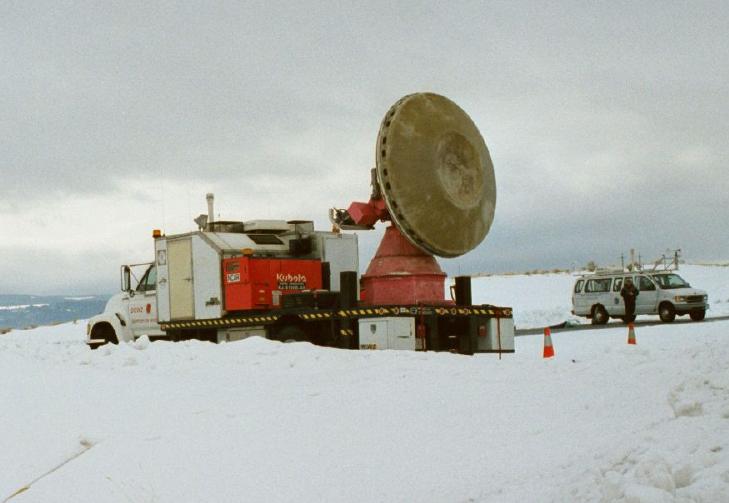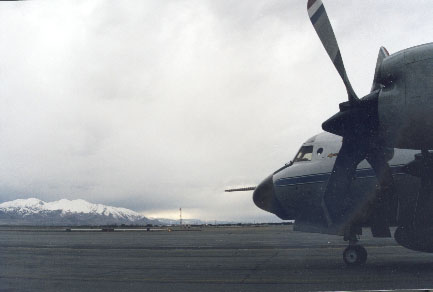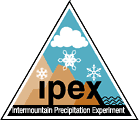The Intermountain Precipitation Experiment (IPEX) is a field and research program designed to improve the understanding, analysis, and prediction of precipitation and precipitation processes in complex terrain. Information about the program can be found at the links to the left.
 An article
An article
![]() appeared
in the February 2002 Bulletin of the American
Meteorological Society that describes the IPEX research program:
motivation, scientific objectives, field-phase research, outcome,
preliminary results, and lessons learned.
appeared
in the February 2002 Bulletin of the American
Meteorological Society that describes the IPEX research program:
motivation, scientific objectives, field-phase research, outcome,
preliminary results, and lessons learned.
The project is led, in part, by Dr. David Schultz of the
Mesoscale Applications
Group and Dr. Jeff Trapp (now at Purdue University) and involves
scientists from the National Severe
Storms Lab (NSSL), University
of Utah ![]() , Desert
Research Institute (DRI)
, Desert
Research Institute (DRI) ![]() , and staff from the National
Weather Service Office in Salt Lake City ,
, and staff from the National
Weather Service Office in Salt Lake City , ![]() Hydrometeorological
Prediction Center
Hydrometeorological
Prediction Center ![]() , and Storm
Prediction Center
, and Storm
Prediction Center ![]() . Students from the University of Utah and University
of Oklahoma
. Students from the University of Utah and University
of Oklahoma ![]() also
participated. The field phase was held 31 January - 25
February 2000. The major scientific objectives of IPEX are:
also
participated. The field phase was held 31 January - 25
February 2000. The major scientific objectives of IPEX are:
- to advance fundamental knowledge of orographic precipitation, with an emphasis on the narrow, steeply sloped Wasatch Mountains of northern Utah,
- to improve knowledge of lake-effect precipitation of the Great Salt Lake,
- to validate and improve high-resolution data-assimilation systems, mesoscale model performance, and quantitative-precipitation forecasts over complex terrain,
- to validate and improve quantitative-precipitation estimates produced by WSR-88D's located at high elevation, and
- to collect the first balloon-borne measurements of electric-field profiles in continental winter storms in the United States.
 IPEX
observing platforms include two NSSL mobile
laboratories with Cross-chain LORAN Atmospheric Sounding Systems
(CLASS), two, OU
Doppler weather radars on wheels (DOW)
IPEX
observing platforms include two NSSL mobile
laboratories with Cross-chain LORAN Atmospheric Sounding Systems
(CLASS), two, OU
Doppler weather radars on wheels (DOW) ![]() , a NOAA P-3 research
aircraft, Univ. of Utah's
dual-frequency microwave radiometer, a
vertically pointing Doppler radar (Radian, Corporation and the Salt
River Project), and supplemental soundings from National Weather
Service upper-air observing sites. These platforms enhance an existing
surface observing system known as the Utah
Mesonet
, a NOAA P-3 research
aircraft, Univ. of Utah's
dual-frequency microwave radiometer, a
vertically pointing Doppler radar (Radian, Corporation and the Salt
River Project), and supplemental soundings from National Weather
Service upper-air observing sites. These platforms enhance an existing
surface observing system known as the Utah
Mesonet ![]() .
.
Data collected allow project scientists to examine a number of questions and testable hypotheses concerning the interaction of dynamical and microphysical processes during orographic precipitation events, including factors controlling the distribution and intensity of precipitation across a narrow, steeply sloped mountain range like the Wasatch Mountains. Other project activities include validating and improving mesoscale model quantitative precipitation forecasts, human-produced forecast products, and quantitative precipitation estimates from WSR-88D radars. Data collected during IPEX has been used for validation studies of orographic precipitation by scientists at SUNY Stony Brook and Yale University.
FORMAL PUBLICATIONS
- NEW Shafer, J. C., W. J. Steenburgh, J. A. W. Cox, and J. P. Monteverdi, 2005: Terrain influences on synoptic storm structure and mesoscale precipitation distribution during IPEX IOP3. Mon. Wea. Rev., in press. [PDF]
- NEW Colle, B. A., J. B. Wolfe, W. J. Steenburgh, D. E. Kingsmill, J. A. W. Cox, and J. C. Shafer, 2005: High-resolution simulations and microphysical validation of an orographic precipitation event over the Wasatch Mountains during IPEX IOP3. Mon. Wea. Rev., 133, 2947-2971. [AMS] [PDF]
- NEW Cox, J. A. W., W. J. Steenburgh, D. E. Kingsmill, J. C. Shafer, B. A. Colle, O. Bousquet, B. F. Smull, and H. Cai, 2005: The kinematic structure of a Wasatch Mountain winter storm during IPEX IOP3. Mon. Wea. Rev., in press. [AMS] [PDF]
- Barstad, I. and R. B. Smith, 2005: Evaluation of an orographic precipitation model. J. Hydrometeor., 6, 85-99.[AMS] [PDF]
- Schultz, D. M., and R. J. Trapp, 2003: Nonclassical cold-frontal structure caused by dry subcloud air in northern Utah during the Intermountain Precipitation Experiment (IPEX). Mon. Wea. Rev., 131, 2222-2246. [AMS] [PDF] [HTML] (First Annual CIMMS Outstanding Paper Award, 2005)
- Rust, W. D., and R. J. Trapp, 2002: Initial balloon soundings of the electric field in winter nimbostratus clouds in the USA. Geophysical Research Letters, 29(20), 1959, doi:10.1029/2002GL015278. [PDF]
- Schultz, D. M., W. J. Steenburgh, R. J. Trapp, J. Horel, D. E. Kingsmill, L. B. Dunn, W. D. Rust, L. Cheng, A. Bansemer, J. Cox, J. Daugherty, D. P. Jorgensen, J. Meitin, L. Showell, B. F Smull, K. Tarp, and M. Trainor, 2002: Understanding Utah winter storms: The Intermountain Precipitation Experiment. Bull. Amer. Meteor. Soc., 83, 189-210. [AMS] [PDF] [PDF-extended version (draft)] [HTML-extended version]
INFORMAL PUBLICATIONS
- Colle, B. A., J. Wolfe, J. Steenburgh, D. Kingsmill, J. A. W. Cox, and J. Shafer, 2005: High resolution simulations and microphysical validation of an orographic precipitation event over the Wasatch Mountains during IPEX IOP3. Preprints, 21st Conference on Weather Analysis and Forecasting/17th Conference on Numerical Weather Prediction, Washington, DC, Amer. Meteor. Soc., 9.7. [AMS]
- Colle, B. A., M. Garvert, J. A. W. Cox, W. J. Steenburgh, D. E. Kingsmill, J. B. Wolfe, and C. P. Woods, 2004: Some comparisons between IMPROVE-2 and IPEX kinematic and precipitation structures and bulk microphysical verification. Preprints, 11th Conference on Mountain Meteorology and the Annual Mesoscale Alpine Program (MAP), Bartlett, NH, Amer. Meteor. Soc. [AMS]
- Steenburgh, W. J., J. A. W. Cox, J. C. Shafer, D. E. Kingsmill, and B. A Colle, 2003: Orographic precipitation processes over the Wasatch Mountains during IPEX IOP 3. Preprints, 10th Conf. on Mesoscale Processes, Portland, OR, Amer. Meteor. Soc. [PDF]
- Ladue, J. G., 2002: The structure of a tornadic bow echo in Idaho. Preprints, 21st Conf. on Severe Local Storms, San Antonio, TX, Amer. Meteor. Soc.
- Shafer, J. C., W. J. Steenburgh, and J. A. W. Cox, 2002: Analysis of an orographically modified cyclone over the western United States during IPEX IOP 3. Preprints, Tenth Conf. on Mountain Meteorology, Park City, UT, Amer. Meteor. Soc. [PDF]
- Kingsmill, D. E., H. Cai, J. A. W. Cox, W. J. Steenburgh, 2002: Microphysical structure of orographic precipitation along the Wasatch Mountains during IPEX. Preprints, Tenth Conf. on Mountain Meteorology, Park City, UT, Amer. Meteor. Soc. [PDF]
- Schultz, D. M., 2002: Structure and evolution of a tornadic cold front in the Intermountain West. Preprints, Tenth Conf. on Mountain Meteorology, Park City, UT, Amer. Meteor. Soc. [AMS]
- Cox, J. A. W., W. J. Steenburgh, and D. E. Kingsmill, 2002: Dual-Doppler analysis of the kinematic structure of a Wasatch mountain winter storm. Preprints, Tenth Conf. on Mountain Meteorology, Park City, UT, Amer. Meteor. Soc. [PDF]
- Cox, J. A. W., W. J. Steenburgh, D. E. Kingsmill, and B. A. Colle, 2001: Orographic precipitation processes associated with the Wasatch Mountains during IPEX IOP3. Preprints, Ninth Conf. on Mesoscale Processes, Fort Lauderdale, FL, Amer. Meteor. Soc., 196-197. [PDF]
- Schultz, D. M., W. J. Steenburgh, R. J. Trapp, D. Kingsmill, L. Dunn, 2000: Preliminary Results from the Intermountain Precipitation Experiment. Preprints, Ninth Conf. on Mountain Meteorology, Aspen, CO, 316-317. [HTML]
- Ciliberti, C. M., J. D. Horel, and S. M. Lazarus, 2000: Sensitivity Experiments With a High Resolution Data Assimilation Scheme. Preprints, Ninth Conf. on Mountain Meteorology, Aspen, CO, 413-416. [PDF]
THESES
- Shafer, J. C., 2002: Synoptic and Mesoscale Analysis of Wasatch Mountain Snow Storm. M.S. thesis, Department of Meteorology, University of Utah, 70 pp. [PDF]
- Cox, J. A. W., 2002: Kinematic structure of a Wasatch Mountain snowstorm. M.S. thesis, Department of Meteorology, University of Utah, 60 pp. [PDF]
- Cheng, L., 2001: Validation of Quantitative Precipitation Forecasts During the Intermountain Precipitation Experiment. M.S. thesis, Department of Meteorology, University of Utah, 137 pp. [HTML]
ONLINE PRESENTATIONS
Intermountain Weather Workshop: 7 November 2002
- J. Shafer and W. J. Steenburgh. Synoptic and Mesoscale Structure of a Wasatch Mountain Winter Storm
- J. Cox, W. J. Steenburgh, D. Kingsmill. Dual-Doppler Observed Kinematic Structure of a Wasatch Mountain Winter Storm
- D. Kingsmill, H. Cai, J. Cox, J. Steenburgh. Microphysical structure of orographic precipitation along the Wasatch mountains during IPEX
- D. M. Schultz and R. J. Trapp. NSSL. Microscale and Precipitation Structure of a Squall Line and Associated Cold Front in Northern Utah during IPEX
Mountain Meteorology Conference: August 2000
- Cheng et al.: Quantitative Precipitation Forecasts [PDF file]
- Steenburgh: Overview of the IPEX Field and Research Program
- Schultz et al.: Preliminary Results from IPEX
- Cox et al.: Kinematic Aspects of Orographic Precipitation During IPEX IOP 3
- Nelson: Short-Range Ensemble Forecasts During IPEX
- Vasiloff: '98-'99 Utah Winter Storm Study: Radar Versus Precipitation Gauge Data (Including IPEX Results)
Mountain Meteorology Conference: August 2000
- Cheng et al.: Quantitative Precipitation Forecasts [PDF file]
- Schultz et al.: Preliminary Results from IPEX
Media: For Public Affairs support, please contact one of the NOAA PA representatives:
Marilu Trainor |
Keli Tarp |
Comments or Questions (David Schultz) Last updated 3 December 2005 DMS.

